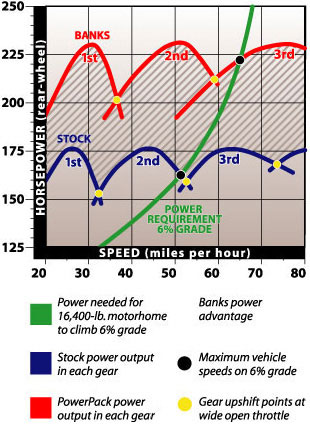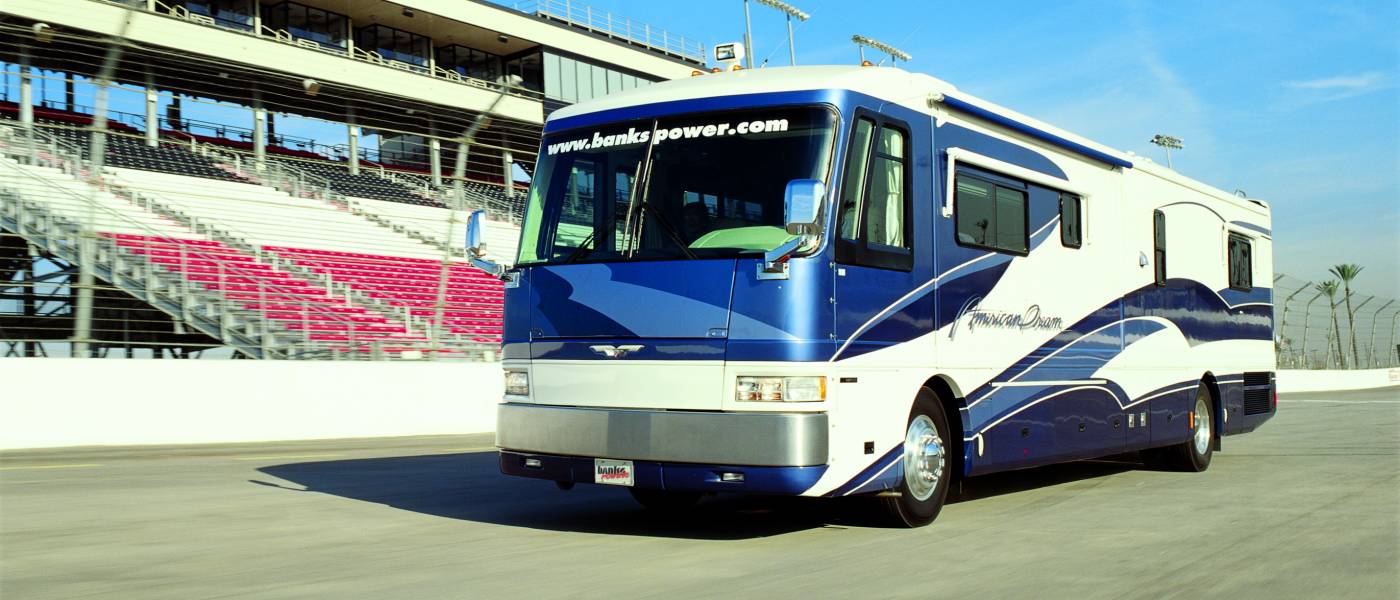Making Your Motorhome Better Than New
By removing intake-and-exhaust restrictions that limit an engine’s power potential, Banks Power products liberate horsepower and torque.

As this typical motorhome accelerates up a hill, its power requirement increases. Note that there is a loss of available power as the coach approaches each gear change. With Banks PowerPack® installed, there is more power at every point on the vehicle’s journey. It can sustain faster speeds as it pulls the grade, and remain in higher gear longer.
I founded my company, Gale Banks Engineering, in 1958, but it wasn’t until the first fuel crunch of 1974 that we began developing engine-power products for motorhomes. Banks was primarily known for building and customizing high-performance vehicles, with a heavy emphasis on turbocharging gas and diesel engines. That experience as “California hot-rodders” provided a solid background optimizing engines for power and durability. In the competitive world of endurance racing, we earned a number of marine and land-speed championships, including World’s Fastest Passenger Car (that record held for better than a decade), and World’s Fastest Pickup (record unbroken to this day).
But RVs presented new challenges. One thing’s become apparent to me through the ensuing years: they keep getting bigger! Once they reach the legal length, they go and get wider. And heavier: the manufacturers pack in a lot more gear, and people tow more dinghies, too. To motivate all that mass requires a lot of power-not the easiest feat, when the object you’re propelling has the aerodynamics of a brick.
Even though the engine suppliers are slowly catching up, it seems there’s a never-ending chase for more power. Today’s rigs are fine for 70 or 75% of buyers, but they don’t satisfy the remainder. Fulfilling the needs of RV owners who want a higher level is where aftermarket power-enhancing products-like Banks Power systems-fit in.
We engineer, test and manufacture Banks Power products at our facility in Azusa, California. I believe that the approach we take is unique in our industry. Our racing heritage established exceptional standards in power, durability, fuel economy and engine efficiency. Out on the Bonneville Salt Flats, or running up a river in New Zealand, our high-performance engines required the power to sustain incredible speed-but even more importantly, they needed to possess the durability to finish the race. The demands of endurance racing honed our aptitude for developing engines so efficient that they could be raced many times, to win multiple championships. That foundation gives the Banks engineers a definitive advantage in designing power products for everyday use.
Contrary to what you might imagine, Banks Power products do not “make” more power-by removing intake-and-exhaust restrictions that limit an engine’s power potential, they literally liberate horsepower and torque. In diesel applications, we know that simply amping up the fuel flow will increase power, but that is a sure way to kill an engine. By starting our power-enhancement process with improved airflow into the engine, and slashing backpressure at the exhaust end, we are able to meter in fuel to match the increased airflow. That accomplishes a number of things: it achieves the optimum air-fuel ratio; maintains a lower exhaust-gas temperature (EGT); improves engine efficiency; meets or exceeds emissions standards; lessens engine wear-and-tear; and unleashes monumental gains in horsepower and torque.
There’s another thing we discovered, after applying our “airflow always first” rule-fuel economy improves. If you consider what Banks does for an engine, you realize that mileage must come with the bargain. Hot engines drain power: by increasing airflow, Banks-equipped engines run cooler. Engines that have diminished airflow (i.e., “pumping losses”) must work harder to produce horsepower and torque: Banks removes factory restrictions to flow in more cold, dense air at the intake, and runs a free-flowing exhaust that actually extracts exhaust-gas. Engines that are starved for air waste fuel: with higher-pressure air in the cylinders, the fuel that is introduced into the combustion chambers is not wasted. The bottom line is, when proper airflow is present, mileage can’t help but improve.
A Banks Power product is the power option you can’t get from the factory. For Ford and GM gasoline motorhomes we offer up to three system levels: Git-Kit, Stinger and PowerPack®. Top-of-the-line PowerPacks typically combine a free-flowing Banks Ram-Air intake with a 100% stainless-steel exhaust system comprised of Banks TorqueTube manifolds, Dynaflow muffler, and Monster exhaust pipes. Unlike others’ modified headers, our TorqueTubes are the only tuned-length exhaust manifolds designed specifically for motorhomes. TorqueTubes release colossal torque when you call for it-so you pedal out of the hole quicker, merge faster, and march up steep grades without unnecessary backshifting.
Cummins diesel pushers benefit from up to two options, Stinger or PowerPack. Both systems reduce the power required to turn the turbocharger, provide higher peak boost, and achieve full boost faster, for strong acceleration without turbo lag. PowerPacks add custom-engineered intake components to the Stinger platform, to optimize and balance ram-air in the intake tracts.
Modern engines require electronic engine management devices, so we have developed the OttoMind engine calibration module, included in Cummins 24-valve applications, and optional for the Ford V-10. This device uses sophisticated software to manage fuel flow according to dynamic conditions, always maintaining the optimal mix without over-tuning your engine. In diesel applications, exclusive features we call “TLC” prolong drivetrain longevity. So, instead of selling just “parts,” Banks power products take a system approach that combines streamlined intake and exhaust components that work in concert with our fuel-management technologies.
At Banks, we perform comprehensive dynamometer and road tests, and publish the results for all our product applications. Along with capturing a host of power and performance data, we measure the stock vs. Banks distance required to go 0-to-60 mph and 40-to-60 mph. How many feet does it takes you to merge with freeway traffic, and to safely pass? Time-to-achieve speed is a captivating statistic in racing, but when you’re moving a rig down the highway, it’s distance that’s really meaningful. We want to get you from a standstill to 60 mph within 1,000 feet-a typical onramp. Usually that means our product knocks about a football field off the stock distance. And Banks Power cuts way back on how much of the “wrong” side of the road you need to occupy in order to get around that farmer in front of you.
We apply the winning methodology we developed in racing-for 42 years now-to equip trucks, SUVs and motorhomes with the most powerful, durable, fuel-efficient and reliable engines on the road today. We have a saying: no matter what model year your vehicle is, with Banks, it’s Better Than New.

